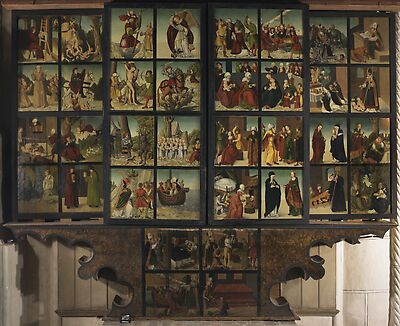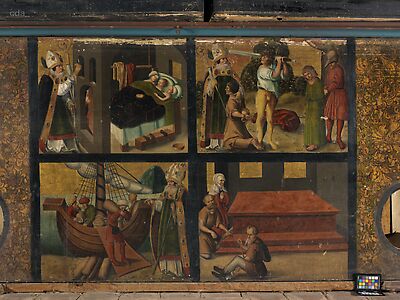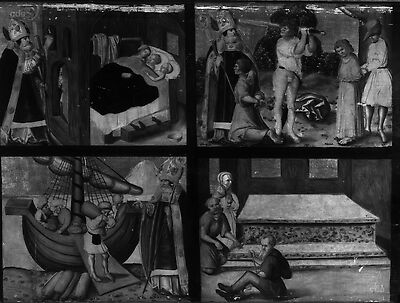Scenes from the Legend of St Nicolaus
DESCRIPTION
Tools/Material:
- fluid, black medium, brush
Type/Ductus:
- detailed and freehand underdrawing after a pre-existing design
- thin to broader lines
Function:
- relatively binding for the final painted version; the lines define the main contours, describe essential details and facial features; no representation with hatching strokes
Deviations:
- corrections were made to forms during the painting process; small changes (e. g. the arms of the daughters)
INTERPRETATION
Attribution:
- not possible (not Cranach workshop)
2.
DESCRIPTION
Tools/Material:
- fluid, black medium, brush
Type/Ductus:
- detailed and freehand underdrawing after a pre-existing design
- thin to broader lines
Function:
- only relatively binding for the final painted version; the lines define the main contours, describe essential details and facial features; no representation with hatching strokes
Deviations:
- corrections were made to forms during the painting process; numerous small changes (e. g. the position of the leg and the head of the executioner)
INTERPRETATION
Attribution:
- not possible (not Cranach workshop)
3.
St Nicholas Feeds the Starving
DESCRIPTION
Tools/Material:
- fluid, black medium, brush
Type/Ductus:
- detailed and freehand underdrawing after a pre-existing design
- thin to somewhat broader lines
Function:
- relatively binding for the final painted version; the lines define the main contours, describe essential details and facial features; not representation of volume with hatching strokes
Deviations:
- corrections were made to forms during the painting process; small changes
INTERPRETATION
Attribution:
- not possible (not Cranach workshop)
4.
The Healing of the Lame
DESCRIPTION
Tools/Material:
- fluid, black medium, brush; an initial design may have been executed with a stylus
Type/Ductus:
- relatively detailed and freehand underdrawing after a pre-existing design
- thin to somewhat broader lines
Function:
- relatively binding for the final painted version; the lines define the main contours, describe essential details and facial features; no representation of volume with hatching strokes
Deviations:
- corrections were made to forms during the painting process; small changes
INTERPRETATION
Attribution:
- not possible (not Cranach workshop)
[Sandner, Heydenreich, Smith-Contini, cda 2017]
![The Bernau Altarpiece [predella]: St Nicholas legend](https://lucascranach.org/imageserver-2022/DE_StMB_NONE-001g_FR-none/01_Overall/DE_StMB_NONE-001g_FR-none_2016-02_Overall-s.jpg)

![The Bernau Altarpiece [left alteration wing]: Live of the Virgin [recto], Live of Saints [verso]](https://lucascranach.org/imageserver-2022/DE_StMB_NONE-001c_FR-none/01_Overall/DE_StMB_NONE-001c_FR-none_2016-02_Overall-s.jpg)
![The Bernau Altarpiece [right alteration wing]: The childhood of Christ [recto], Live of Saints [verso]](https://lucascranach.org/imageserver-2022/DE_StMB_NONE-001d_FR-none/01_Overall/DE_StMB_NONE-001d_FR-none_2016-02_Overall-s.jpg)
![The Bernau Altarpiece [left inner wing]: Passion of Christ [verso]](https://lucascranach.org/imageserver-2022/DE_StMB_NONE-001a_FR-none/01_Overall/DE_StMB_NONE-001a_FR-none_2016-02_Overall-s.jpg)
![The Bernau Altarpiece [right inner wing]: Passion of Christ [verso]](https://lucascranach.org/imageserver-2022/DE_StMB_NONE-001b_FR-none/01_Overall/DE_StMB_NONE-001b_FR-none_2016-02_Overall-s.jpg)
![The Bernau Altarpiece [left side wing]: The Golden Legend (Aurea Legenda)](https://lucascranach.org/imageserver-2022/DE_StMB_NONE-001e_FR-none/01_Overall/DE_StMB_NONE-001e_FR-none_2016-02_Overall-s.jpg)
![The Bernau Altarpiece [right side wing]: The Golden Legend (Aurea Legenda)](https://lucascranach.org/imageserver-2022/DE_StMB_NONE-001f_FR-none/01_Overall/DE_StMB_NONE-001f_FR-none_2016-02_Overall-s.jpg)

